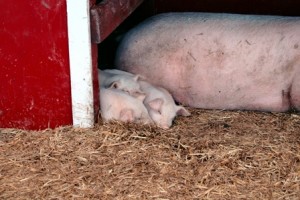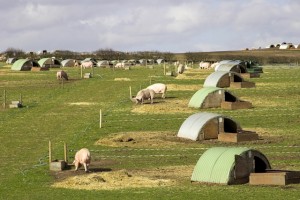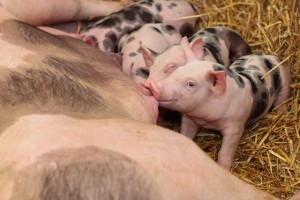Pig Diseases
Piglet Diarrhea
Also known as: Scours. Including Post-weaning Diarrhea
What Causes Piglet Diarrhea?
Common causes of piglet diarrhea include the following:
- Escherichia coli (E. coli) strains are common within the first week of life, and again in the first week after weaning. This is a serious cause of the piglet diarrhea affecting piglets, to read more see Colibacillosis;
- Clostridial enteritis causes acute enteritis and scouring within the first week of life, to read more see Clostridial disease ;
- Coccidia cause scouring commonly between 9 days of age and weaning, to read more see Coccidiosis;
- Transmissible gastroenteritis (TGE and Porcine Epidemic Diarrhea) causes sudden and severe diarrhea in piglets under 3 weeks of age;
- Salmonellosis causes diarrhea in weaned pigs. It is often associated with other diseases; and
- Other causes include Rotavirus, cryptosporidiosis and Brachyspira hyodysenteriae.
Pre-Weaning in Piglets
Diarrhea in pre-weaned piglets is common and can be fatal, but the causes are varied. The onset of diarrhea may occur within a matter of hours, and it is likely to spread rapidly to all piglets in a litter. Piglets can become quickly dehydrated and mortality rates can be high.
Control and Prevention
Treatment Options
Welfare
Good Practice

Diarrhea in pre- and post-weaned piglets can be fatal if severe. There are many different pathogens and factors that can cause diarrhea so outbreaks should be investigated thoroughly.
Post-Weaning Diarrhea in Piglets
The weaning process increases the stress on piglets, and thus their susceptibility to viral and bacterial infections. Diarrhea in these older piglets tends to be less severe, and mortality rates lower. Potential sources of diarrhea at this stage include E. coli, Rotavirus, TGE, salmonellosis, Campylobacter and Brachyspira hyodysenteriae (Bohl et al., 1978; Taylor, 1995).
Porcine Epidemic Diarrhea Virus (PEDv)
Porcine Epidemic Diarrhea Virus (PEDv) is a differential diagnosis to piglet diarrhea, and is caused by a pig coronavirus. There are a range of pig coronaviruses that cause similar diseases around the world, but at present PEDv is the most common and important form globally (McOrist, 2014). PEDv is a devastating enteric disease, with outbreaks tending to occur every 6-12 months, varying in duration and intensity. Piglet mortality is high, but older animals can also be affected, with long term effects on sow performance (McOrist, 2014). PEDv is characterized by watery diarrhea, it appears similar to transmissible gastroenteritis (TGE), and can be confirmed by blood tests or PCR tests. It is a very serious condition and Swine Enteric Coronavirus Diseases, including PEDv, are reportable to the USDA. If you suspect PEDv on your farm, contact your veterinarian immediately.
Control and Prevention of Piglet Diarrhea
Piglet diarrhea is a threat in most herds and a range of different infections can be expected to exist in the environment, regardless of control measures. Nevertheless, the incidence and severity of diarrhea outbreaks are often closely associated with herd management factors well within the control of the stockperson (Hill and Sainsbury, 1995).
Maintenance of Disease Resistance
Maternal antibodies provided through colostrum are the primary protection against piglet diarrhea and its effects on pre-weaning piglets. Resistance to disease is also associated with the general well-being of individual animals, and excessive levels of stress should be avoided where possible (Cowart, 1995; Hill and Sainsbury, 1995; Taylor, 1995).
Maintenance of disease resistance can be enhanced in two ways:
- By ensuring adequate colostrum intake in the first hours after farrowing (not always practical and easy in extensive outdoor systems); and
- By ensuring good antibody development in the sow before farrowing. The development of active immunity in sows against the prevalent pathogens can be enhanced by controlled exposure of maiden gilts to dung from the farrowing unit in the introduction/acclimatization paddock before mating. If weaner gilts are bought into the unit, they should be introduced to the herd as early as possible after an appropriate period of isolation, to allow immunological acclimatization.
There are several vaccines available that will incur protection against multiple strains of both E.Coli and Clostridial disease, for vaccination of sows and gilts before farrowing in order to enhance active immunity and production of antibodies in milk. See Colibacillosis for more details.
Reducing Exposure of Piglets to Infection

Build-up of infectious agents that cause piglet diarrhea in farrowing huts can be avoided by cleaning and disinfection between litters and regular provision of dry clean bedding.
Exposure of piglets to pathogens that cause diarrhea is linked to hygiene practises and bacterial growth and survival in the immediate environment of the piglet. Poor hygiene will allow bacteria and other pathogens to proliferate. Initial infections can be greatly reduced by a good level of hygiene and farrowing accommodation management. In farrowing paddocks, huts should be disinfected between litters, and bedding in each hut kept fresh, clean and dry. Huts should be moved between litters, and paddocks moved annually. Cold, wet, draughty conditions are likely to exacerbate infections, and huts should be kept enclosed, dry and warm, particularly in colder weather.
Good Sow and Piglet Feeding Practice
Inappropriate or excessive feeding of sows can further exacerbate infections, and regulated high fiber and high protein diets are advisable.
One of the consequences of incomplete starch digestion in the small intestine may include excessive large intestinal fermentation leading to diarrhea and dehydration. Starch from peas is digested less well in the small intestine than from cereals (Wiseman, 2006).
Some feeds, such as processed soya bean products, particularly cooked soya bean and tempeh, a cooked and mold-fermented product, may be beneficial in the case of post-weaning diarrhea in piglets (Kiers et al., 2003, 2006).
Almost all diarrhea will result in dehydration, and control of increasing morbidity and mortality may be prevented by timely introduction of rehydration with glucose-based fluids.
Treating Piglet Diarrhea
In a case of diarrhea outbreak in a herd, it is important to diagnose the infective cause of the disease promptly and accurately in order to target further control measures appropriately. Antimicrobial sensitivity testing should be used to ensure the correct products are used and there issues with antimicrobial resistance are not amplified. Isolation and provision of rehydrating, glucose-based fluids can be helpful in weaned piglets. Also combined antimicrobials may be effective in addressing a number of potential infections, but their efficacy cannot be guaranteed (Cowart, 1995; Taylor, 1995).
Reference should be made to treatment measures for specific causes of diarrhea:
- Clostridial infections
- Coccidiosis
- E. coli
- Salmonellosis
- Transmissible gastroenteritis (TGE)
- Porcine Epidemic Diarrhea Virus (PEDv)
The demonstrated positive effect of zinc supplementation on diarrhea in weaned piglets may be due to zinc reducing the intestinal mucosal susceptibility to secretagogues that activate chloride secretion (Carlson et al., 2004).
Piglet Diarrhea and Welfare
Early weaning should be avoided as it is likely to increase risk for post-weaning scours. Maternally derived passive immunity does not prevent infection, but does prevent expression of clinical disease while active immune defences are being formed in later weaned animals (Fangman and Tubbs, 1997).
If a unit has a serious E. coli problem, the situation should be improved with a combination of husbandry and hygiene changes and vaccination of sows/gilts.
Good Practice Based on Current Knowledge
In order to control piglet diarrhea, the situation on the farm needs to be assessed in order to decide whether a disease reduction plan needs to be developed.
-
Maintain good immune status and antibody production in sows by exposing maiden and weaned gilts early enough (minimum four weeks before farrowing) to prevailing pathogens in farrowing units (this will only be helpful in controlling E. coli infection and may be contraindicated if the herd suffers from clostridial enteritis)
- Supervise farrowing and suckling to ensure adequate colostrum intake. A balance has to be struck here as in extensive systems, night time farrowing means that supervision is not always possible without causing unnecessary disturbance, which in turn can result in increased mortality if the sow is standing up and laying down
- Decrease exposure to pathogens by disinfecting huts between litters, by keeping bedding in each hut fresh, clean and dry and by moving huts between litters and paddocks annually
- Plan your rotations and paddock changes so that farrowing paddocks can be changed between litters and piglets can be weaned on to clean ground
- Decrease stress by protecting litters from bad weather
- Wean late: piglets should be at least six weeks of age at weaning
- Reduce stress at weaning by allowing piglets to mix before weaning
- Wean piglet onto clean ground (i.e., no pigs in the previous 12 months)
- In the case of an outbreak or continuous problems with scours, identify the causative agents and factors and develop a written disease control plan with the vet
- Vaccinate gilts and sows against E. coli/Clostridial disease, if problems cannot be solved by improved husbandry. If vaccination is introduced, it should be part of a written plan to reduce disease incidence by other methods (i.e., husbandry and hygiene) as well


 British English
British English


Comments are closed.